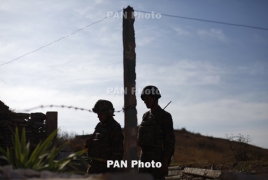 Baku fires howitzers amid global community’s idle sighsRealizing the mediators and world powers cannot be relied on, Armenia pledged to punish Azerbaijan itself. The longer powers interested in the Karabakh conflict settlement, international organizations and the OSCE Minsk Group mediators keep silent, the more uncontrollable Azerbaijan becomes, trying to turn the situation in the conflict zone into a full-scale war. PanARMENIAN.Net - The fact that the absence of adequate response to Azerbaijan's provocations in the Karabakh conflict zone will lead to a further escalation of tension was much talked about. Inspired by its own impunity, Baku has for years thwarted peace talks, creating dangerous situation at the line of contact with Nagorno Karabakh and on the border with Armenia. Throughout the 20 years after signing the ceasefire agreement in 1994, Azerbaijani armed forces violated truce with surprising regularity, opening fire on Armenian military positions, villages and civilians. They shelled from assault rifles, machine guns, sniper rifles. Azerbaijan “marked” the 20th anniversary of that very Bishkek protocol by escalating the situation and using larger-caliber weapons. In December 2014, for the first time in many years, 60- and 82-mm mortars were used to shell Armenian position. The international community signed worriedly, shook its head, called on all parties (!) to maintain ceasefire and fell silent. On November 12, 2014, an Armenian Mil Mi-24 attack helicopter was shot down by Azerbaijani Armed Forces, killing all three crew members. After the shoot-down, Azeri forces continued shelling the crash site, preventing Armenian forces from retrieving the bodies for several days. On November 22, 2014, units of Armenian special forces successfully recovered the slain bodies of the three Armenian pilots, along with parts of the helicopter. Meanwhile, Azerbaijan started using grenade launchers in January, 2015, with international mediators still worriedly sighing. 120-mm mortars came to be used in March, 2015. While grenade launchers and mortars continued to fire, the OSCE Minsk Group Co-chairs continued to actively "not understand" who is to blame for the escalation. In August, Azerbaijani armed forces began firing from Turkish-made TR-107 rocket launchers. They shelled, in particular, a Karabakh position on August 25, with the NKR defense army servicemen Norayr Khachatryan (born 1995), Robert Mkrtchyan (born 1995), Harout Hakobyan (born in 1997) and Karen Shahinyan (born in 1997) receiving deadly shrapnel wounds. On September 26 for the first time in 20 years, Azeris used 122-mm howitzer D-30 to shell the Armenian positions. What about the mediators? The mediators, along with the same international community, continue sighing, shaking their heads and doing next to nothing to resolve the issue. This time, by the way, the OSCE Minsk group Co-chairs openly declared they did not know who to blame. “While we are unable to determine with certainty how the violence originated since each side accuses the other, the parties should work towards an OSCE investigation mechanism as discussed between the Presidents,” the mediators said in a statement. Later, however, the Co-chairs called for the Presidents of Armenia and Azerbaijan to accept an OSCE mechanism to investigate ceasefire violations. Without such a mechanism, they said, the sides will continue to blame each other for initiating deadly attacks on the line of contact and Armenia-Azerbaijan border. “Armenia has agreed to discuss the details of the mechanism, and we urged Azerbaijan to do the same,” the Co-chairs stated. Meanwhile, the Armenian Defense Ministry issued a statement to draw the OSCE Minsk Group’s and the international institutions’ attention to Azeri aggression. The Ministry said, in particular, that Azerbaijan’s usage of artillery weapons escalates the situation at the contact line in Karabakh conflict zone, which is another step towards large-scale military actions. The Defense Ministry stressed that consistent escalation by Azerbaijan, as well as the international community’s unaddressed criticisms and statements of concern are unacceptable. “Therefore, in order to silence the rival, stop its actions and thereby contribute to the negotiation process, the Armenian armed forces will from now on take adequate measures to destroy artillery and missiles, keeping a constant eye on places of deployment of units of the Azerbaijani armed forces, all their moves, military equipment and manpower,” the Ministry said in a statement. The international community continues shaking its fingers at everybody. And since finger-shaking is unlikely to scarе Baku, what should the Armenian side expect? A Grad, an Uragan, or a Smerch? Marina Ananikyan / PanARMENIAN.Net Who is who in the web of so many Sargsyans Controversy in quotations There will be no ideal solution Split of opposition votes 6 simple facts about Armenia–Karabakh–Azerbaijan triangle Main arguments of Armenia’s first President Bizarre election promises |